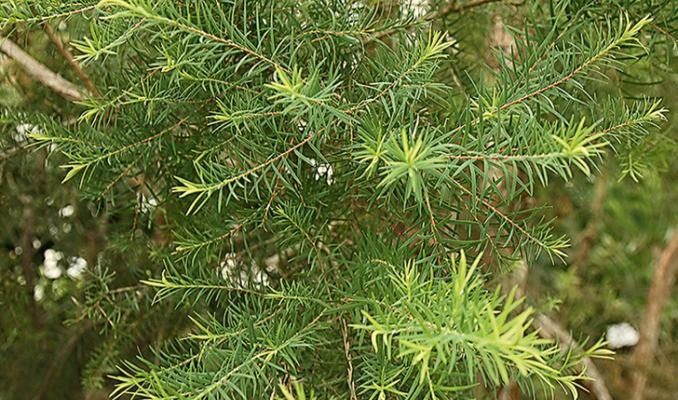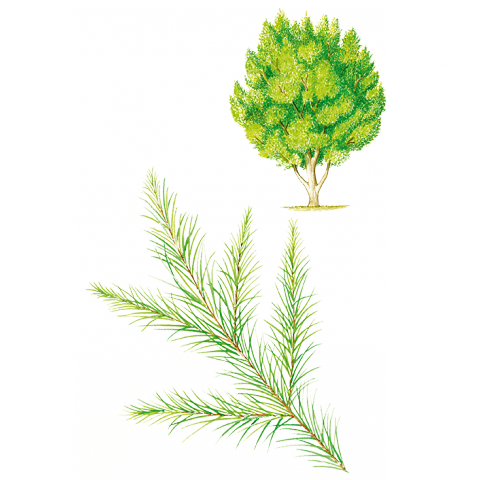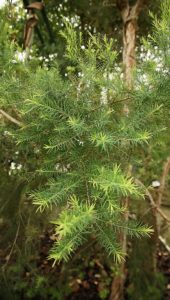
Find out more about the Tea Tree plant of our Aromatherapy Herbarium blog series.

TEA TREE
Melaleuca alternifolia
DIRECTIONS

The tea tree (Melaleuca alternifolia) native to Australia, belongs to the Myrtacaea family.
ADVICE
Essential oil of tea tree, which is very well tolerated, should preferably be used diluted, especially in sensitive subjects.
DO NOT USE IN
– pregnant or breast-feeding women,
– children under the age of three years,
– persons with kidney problems,
– persons allergic to one of the components (limonene),
– persons with asthma without the advice of an allergologist before the first use.
RECIPES
Acne
1 drop of EO of tea tree. Apply on spots, tip by tip, three times daily until improvement.
Mild burns, child cuts
4 drops of EO of true lavender, 2 drops
of EO of tea tree. Apply this mixture on the wounds three times daily for three days. (Not suitable for children under the age of three years.)
Childhood Sore Throat
Give the child three times daily for six days, 1 drop of essential oil of tea tree in some honey. (Not suitable for children under the age of six years.)
3 drops of EO of tea tree, 2 drops of neutral CO.
You can also use the above mixture applied to the neck (lymph nodes), sternum or the chest, three times daily until recovery.

It is leafy, with upright branches and evergreen, it can reach up to seven metres and has small lanceolate leaves. Its fruits are small capsules containing elongated seeds and its flowers have five petals and are very fragrant.
Why call a tree that has nothing to do with tea “tea tree”? It was discovered in Australia by the naturalists accompanying Cook on his second voyage in the Endeavour (1772-1775), when it was given this misleading name. Did its leaves actually replace the tea that the great navigator’s crew lacked so direly? Another version says that an Australian lake where ill people who bathed in it were healed was surrounded by beneficial trees whose leaves fell into the water and infused under the sun. Whatever the truth, the healing virtues used by the Aboriginals were so obvious that the soldiers from the Second World War Australian expeditionary force included tea tree in their field pharmacy.
CULTIVATION AND PRODUCTION
The genus includes more than eighty species which grow especially in Australia, but also in New Caledonia, New Zealand, Borneo, Java and Sumatra.
FRAGRANCE
The essential oil of tea tree has a strong turpentine and camphor-like odour, even though it does not contain any camphor.
EXTRACTION AND YIELD
The essential oil of tea tree is extracted by steam distillation of leaves with a yield of 1%. 1 kilogram of essential oil for one hundred kilograms of plant.
CHEMICAL FORMULA
The main active components of essential oil of Melaleuca alternifolia are monoterpenols (48%): terpinen-4-ol, alpha-terpineol, monoterpenes (40%) and sesquiterpenes (10%).
MAIN INDICATIONS
Essential oil of tea tree is strongly anti-infectious, anti-bacterial and anti-fungal. It is also anti-viral and acts against influenza, dengue, chikungunya and eruptive diseases of childhood. It treats through its broad spectrum all mouth (mouth ulcers, gingivitis), ENT and bronchial domain (sinusitis, pharyngitis, rhinitis, tracheitis and bronchitis) and digestive system (enteritis and enterocolitis) infections. It is also used successfully for all cutaneous infections, parasites and fungi (acne, cuts, herpes, psoriasis, Herpes zoster, warts, dry patches, cutaneous, genital, skin fold mycoses, athletes foot, etc.) It also has a decongestant and tonifying action.


Leave a Comment